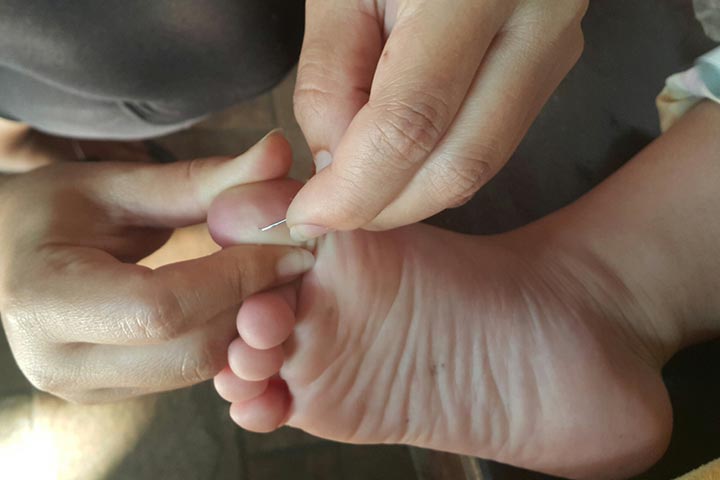Toddlers love to jump around the house, and nothing can stop them. Not to forget, they love to run around barefoot. This increases the risk of them encountering a splinter, making you eventually wonder about how to remove a splinter from your toddler’s foot.
A splinter is the fragment of any object that gets lodged inside the tissues of the feet unintentionally (1). Splinters are usually harmless and can be removed easily with the help of a tweezer, except when it penetrates deep into the skin, increasing the chances of an infection. In such cases, consult the doctor immediately. Read on to know how you can easily remove a splinter from your child’s feet.
Read on to know about ways by which you can easily remove a splinter from your child’s feet.
Steps To Remove A Splinter From The Toddler’s Foot
So, your little walker got a splinter, now what? Don’t worry. Splinters in toddlers are common and mostly harmless, unless it gets impacted or infected. In fact, you can easily remove a small splinter at home. Here’s what you need to do (2):
Step 1: Calm down – both of you. Your little one needs you to be calm. She is scared enough, in any case! A squirmy toddler is not conducive to first aid.
Step 2: Wash your hands thoroughly with soap and your toddler’s foot (or hands, wherever the splinter has found its way). The last thing you need is an infection.
Step 3: Get help. No matter how much you explain, chances are your toddler will squirm when you try to remove the splinter. So ask another adult to help out to keep the toddler quiet and keep the foot steady.
Step 4: Bring out your tweezers and disinfect them preferably with spirit. Now grab the part of the splinter that is visible and pull it out.
Step 5: If the splinter is not visible and has dug deep, you’ll need a needle. The needle should undergo sterilization before you make a small hole in the skin. Use the needle to lift out the splinter a bit. Now you can remove it with your trusted tweezers!
Step 6: Finally, apply some antibiotic cream on the area and tie a bandage. This will prevent any infection.
4 Alternate Ways Of Removing Splinters From Toddler’s Foot
If tweezers are not your cup of tea, or if your toddler is not letting you come near her with a pair, you’ll need alternate methods for extraction of the splinter. Here are a few home remedies you can try for toddler splinter removal:
1. Use Cello Tape:
Get a piece of cello tape and put it over the tip of the splinter in the wound. Now pull out the tape. The splinter will stick to the adhesive tape and come out. This is a ‘no tear’ solution for removing splinters!
2. Glue It:
You can also use glue to remove a splinter from your toddler’s skin. Put the glue on the affected area, allow it to dry and simply peel it out, along with the splinter!
3. Baking Soda:
If you cannot even see the splinter, baking soda may well be the solution for you! Mix baking soda and water to make a thick paste. Now, smear the paste on a bandage and put over the affected area. Leave for 24 hours. Once you remove the bandage, the splinter should now be visible. You can simply remove it with a pair of tweezers. If it is still not visible, repeat the process for another 24 hours.
4. Drawing salve:
A salve (a topical ointment) is considered helpful for removing splinters or other foreign objects. It softens the skin around the splinter, facilitating the body’s natural process of pushing out the foreign item. The salve speeds up this process by moisturizing the area and incorporating anti-inflammatory ingredients, promoting healing before the incision closes. In addition, it increases blood flow, which aids in pus production. As the pus drains, it carries the foreign item with it.
Apply small amounts of salve to the affected area and gently massage it; the area may feel slightly sore. Leaving it on overnight can be effective; often, just one application is sufficient to remove splinters.
Most splinters are harmless and ease out without causing much harm, bleeding or pain. But there are rare cases of infection that you should be aware of.
When To See Your Doctor?
If you are up to date with your toddler’s vaccination, splinters are not a cause for panic. According to a CDC report, between 2016 and 2019, 80.4% of children received all four doses of the Diphtheria, Tetanus, and Pertussis vaccine by the age of 24 months. But if you have missed a dose or two, there is a slim chance of tetanus, a dangerous infection that can even be fatal. So make sure your child’s schedule is on track. To be careful, it is better to give a tetanus shot if the doctor suggests it.
The other thing to look out for is infection. If you notice swelling, irritation, redness and pus; go to your pediatrician. These are all classic symptoms of infection and need medical intervention. The infection can develop into an abscess.
The graph below represents the number of new tetanus infection cases in different parts of the world. The majority of new cases are seen to occur in South Asia and Sub-Saharan Africa, accounting for about 82% of all tetanus cases globally. South Asia may have more cases of tetanus than other regions, but a 14-fold fall in the incidence rate has been achieved in just three decades, which indicates a positive development.
The global incidence of new tetanus infections (2015-2019)
Source: Tetanus; Our World in Data/ United States: Institute for Health Metrics and Evaluation (IHME)
Prevention Is Better Than Cure
This is one saying that never grows old! Why put your toddler through tears and screams when you can prevent it? All you need to do is follow some simple steps:
- Encourage your toddler to keep her shoes on. Easier said than done! But it is the simplest way to prevent splinters.
- While playing outdoors, check the swings and slides (and other ‘fun’ places). These are the places that are most likely to splinter off. Get them repaired if you can.
- Teach your toddler about ‘unsafe’ things like a piece of glass or a rough piece of wooden toy.
Splinters are painful, but they aren’t reason enough to cocoon your toddler. Allow them to explore instead, and if a splinter does get into your toddler’s skin, try to tweeze it out. If your toddler doesn’t let you touch, you may try using cello tape, glue, or baking soda to remove a splinter from their foot. If the splinter becomes infected or becomes deeply embedded, and you observe swelling, consult your child’s doctor. Also, encourage your children to wear shoes when playing outside to reduce the risk of splinters.
Key Pointers
- Splinters can be removed with tweezers, but medical attention should be sought if they are deep and may cause infection.
- To remove a splinter at home, one should wash their hands and the affected area, sterilize their tools, pull out the splinter, and apply antibiotics and a bandage.
- Other methods for removing splinters include using cello tape, glue, and baking soda paste.
- If the splinter causes redness, swelling, and pus or if a toddler is not up to date with vaccinations, a doctor should be consulted.
- Toddlers should be encouraged to wear shoes while running and jumping to avoid getting splinters.
Having a splinter can be a painful and uncomfortable experience. Learn how to safely remove it and when to seek help in this informative video!














